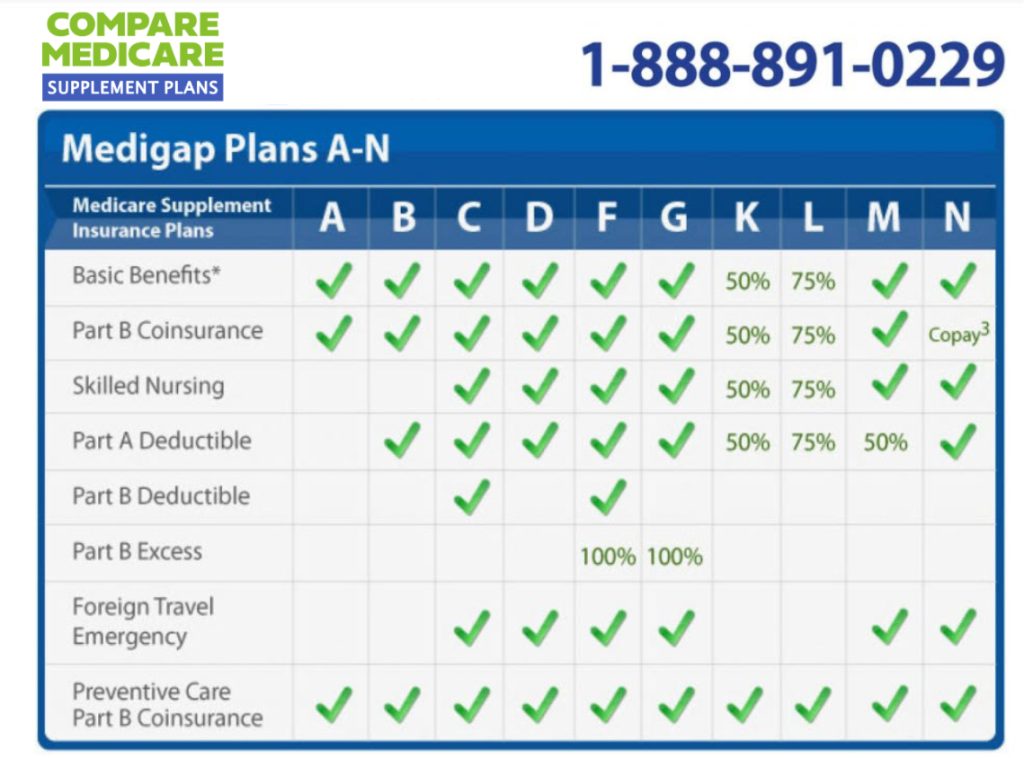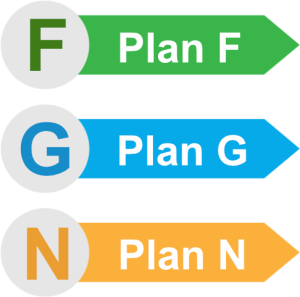What Is Medigap? – Plans, Coverage, Premiums, & Enrollment
In the three months before you turn 65, you’re eligible to join Original Medicare Parts A & B. If you have both policies, you can join a “Medigap” program during the open enrollment period lasting six months from the day of your 65th birthday.
Medigap is supplemental insurance covering 20% of out-of-pocket medical and hospital expenses not covered by Original Medicare.
Medigap helps seniors deal with ever-increasing healthcare costs as they age. Without it, you could face high healthcare expenses.
For example, if you’re involved in an accident while traveling overseas and require emergency healthcare services, Medicare won’t cover this in some instances; they might only cover 20% of these costs.
Your Medigap policy offers coverage for up to 8-0% of these expenses during the first 60 days of travel outside the United States.

There are plenty of other Part A & B out-of-pocket expenses covered by Medigap.
It makes sense to have this supplemental insurance if you want to avoid dipping into your retirement savings in your golden years.
Use the Experts for a Free Professional Consultation and Quote on Medigap Policies
Choosing the right Medigap policy might seem confusing. We offer you a free consultation on the right Medigap policy for your individual health requirements.
Call our fully licensed agents at 1-888-891-0229 for assistance with choosing the right policy for your needs.
Or you can leave us your details on our contact form, and we’ll get a Medigap expert to call you back.
We also have a tool on our site offering you a free automated quote on any Medigap plan.
Compare Plans & Rates
Enter Zip Code
Understanding the Different Medigap Plans
There are ten Medigap plans, each represented by a different letter.
Every plan offers a different level of supplement cover to complement Medicare Parts A & B. Here’s a quick rundown of each policy and its offerings.
- Medigap Plan A — Basic coverage with no extras.
- Medigap Plan B — Basic cover, plus coverage for the Original Medicare Part A deductible.
- Medigap Plan D — Mid-priced Medigap plan covering most Part A & B benefits.
- Medigap Plan F — A fully comprehensive Medigap plan, and the most popular version*.
- Medigap Plan G — The most comprehensive coverage after Plan F. The only thing not covered is the Part B deductible of $226.
- Medigap Plan K — A low-cost option with coverage of 50% for many Parts B & A benefits.
- Medigap Plan L — Another low-cost option with coverage of 75% for many Parts B & A benefits.
- Medigap Plan M — Good coverage for most benefits and 50% of the Part A deductible.
- Medigap Plan N — Low monthly premiums, but copays and Part B excess charges apply.

*Plans F & C are no longer available to seniors eligible for Medicare after January 1, 2020. If you’re eligible for Medicare after this date, you’ll need to go with Plan G instead.
**Both Plans F & G come in “high-deductible” versions available from select providers. This option increases the Part A annual deductible from $1,600 to $2,700, but you get a much lower premium.
What Is the Difference in Coverage Between Medigap Plans?
Every Medigap plan comes with different coverage. The plan you choose depends on the benefits you want and what you can afford to pay in monthly premiums.
Here’s a breakdown of the basic coverage you get with all Medigap plans.
All Medigap policies offer you the following benefits.
- Part A coinsurance and hospital costs for up to 365 days after using up Medicare benefits.
- Part A hospice care coinsurance or copayment.
- Part B coinsurance or copayment.
- Blood transfusion costs for the first three pints of blood.
Plan F, G, and N Offer the following additional benefits for Medicare Parts A & B
- Part A deductible.
- Part B excess charges (Plan N doesn’t cover these charges).
- Skilled nursing facility care coinsurance.
- 80% of emergency healthcare costs when traveling outside the US for 60 days. ($250 deductible and $50,000 maximum apply).
- Unlimited coverage for all out-of-pocket costs.
What Is the Best Medigap Plan? – Plan F Vs. G Vs. N
Plans F, G, & N are the most popular options in the Medigap range.
Plan F was previously the most favorable option due to its excellent coverage; it’s the only one offering coverage for the Part B deductible of $226 in 2023.
However, as mentioned, new enrollees into Medigap eligible for Medicare before January 1, 2020, don’t have access to this policy.

Plan G offers all the same benefits as Plan F. However, the difference between them is that Plan G doesn’t cover the Part B deductible.
However, Plan G offers you lower monthly premiums than Plan F. You’ll get a rate that’s $10 to $40 lower than Plan F from most providers.
So, the savings you make on Plan G over Plan F is usually enough to account for the lack of coverage of the Part B deductible. As a result, Plan G is fast becoming the most popular option.
Plan N is another good choice for healthy seniors that don’t incur many trips to the emergency room or doctor’s office. You get a premium that’s around 20% to 30% lower than plan G and most of the same benefits for emergency care.
 Plan N doesn’t cover the Part B deductible, and you’ll need to make copayments at the doctor’s office ($20) and $50 at the emergency room.
Plan N doesn’t cover the Part B deductible, and you’ll need to make copayments at the doctor’s office ($20) and $50 at the emergency room.
This fee is waived if you aren’t admitted to the hospital for inpatient care.
Plan N also doesn’t cover you for the excess charges associated with seeing doctors charging more than Medicare-approved rates.
Some practitioners can charge up to 15% over the “Medicare Assignment” rate. You’ll have to pay the balance of these costs not covered by Part B.
Plans F & G also come with “high-deductible” versions. These plans increase the annual Part A deductible from $1,600 to $2,700.
In exchange, you get a much lower monthly premium and retain all the standard plans’ benefits.
Where Do I Get a Medigap Plan & What Does It Cost?
Private insurers offer Medigap plans. While the Federal government regulates the Part A & B benefits provided in each policy, they don’t have any say in what the insurer charges for these plans.
As a result, the cost of Plan G or N with one provider may be more expensive than another, and vice versa. Insurers also rely on factors like your gender and smoking status when setting premiums.

They’ll also set your premiums by your age, with some locking you into a specific rate and others charging you more in premiums as you age.
Contact our team, and we’ll find you the lowest rate on any Medigap plan in your state.
Or you can use our free quoting tool on our site to get an idea of the rates available to you in your region.
Frequently Asked Questions
What is Medigap?
Medigap, also known as Medicare Supplement Insurance, is a private health insurance policy designed to fill the gaps in coverage left by Original Medicare (Part A and Part B).
It helps cover out-of-pocket expenses such as deductibles, copayments, and coinsurance, providing beneficiaries with increased financial protection.
How does Medigap work?
Medigap works alongside Original Medicare. When you have both Medicare Parts A and B, Medigap plans pay for certain costs not covered by Medicare.
It acts as a supplement, offering additional benefits depending on the chosen plan, which can vary from covering medical expenses during international travel to extended hospital stays.
Who is eligible for Medigap coverage?
To be eligible for Medigap, you must be enrolled in Medicare Part A and Part B. It’s essential to apply during the Medigap Open Enrollment Period, which begins on the first day of the month you turn 65 and are enrolled in Part B.
During this period, insurers cannot deny you coverage or charge higher premiums based on your health conditions.
What does Medigap not cover?
Medigap does not cover prescription drugs, long-term care, vision, dental care, hearing aids, or eyeglasses. For prescription drug coverage, beneficiaries must enroll in a separate Medicare Part D plan.
How many Medigap plans are available?
There are ten standardized Medigap plans labeled with letters (Plan A, B, C, D, F, G, K, L, M, and N).
Each plan offers a specific set of benefits, with Plan F being the most comprehensive (Note: As of 2020, Plan F is no longer available to newly eligible beneficiaries).
Can I change my Medigap plan?
Yes, you can change your Medigap plan at any time. However, if you want to switch to a different plan or insurance company, you may be subject to medical underwriting, which could affect the premium costs and coverage availability.
How much does Medigap cost?
Medigap premiums vary depending on factors such as your location, age, gender, and the chosen plan. Some states may have different rules regarding pricing, but generally, insurers use community-rated, issue-age-rated, or attained-age-rated methods to determine premiums.
Is Medigap the same as Medicare Advantage?
No, Medigap and Medicare Advantage (Part C) are not the same. While Medigap supplements Original Medicare, Medicare Advantage is an all-in-one alternative managed by private insurance companies.
Medicare Advantage plans often include additional benefits such as prescription drug coverage and may have different cost-sharing structures.
Can I have Medigap and Medicaid at the same time?
Yes, it’s possible to have both Medigap and Medicaid. Medicaid may help cover costs that Medigap does not, depending on your financial situation and the state’s Medicaid program rules.
Can I purchase Medigap coverage if I’m under 65?
Some states offer Medigap plans to individuals under 65 who qualify for Medicare due to disability or certain medical conditions.
However, availability and premium costs may vary, so it’s essential to check with your state’s regulations and insurance providers.
What Is Medigap - How to get started
The easiest way to get started is to call us today at 1-888-891-0229.
We’ll answer all of your questions and help you. Or you can use our FREE quote engine to begin shopping today!

Updated December 4th, 2022


